Excerpts from Jim Conrad's
Naturalist Newsletter
Entry dated December 15, 2023, issued from near Tequisquiapan; elevation about 1,900m, (6200 ft), ~N20.57°, ~W99.89°; Querétaro state, MÉXICO
DESERT INKCAP
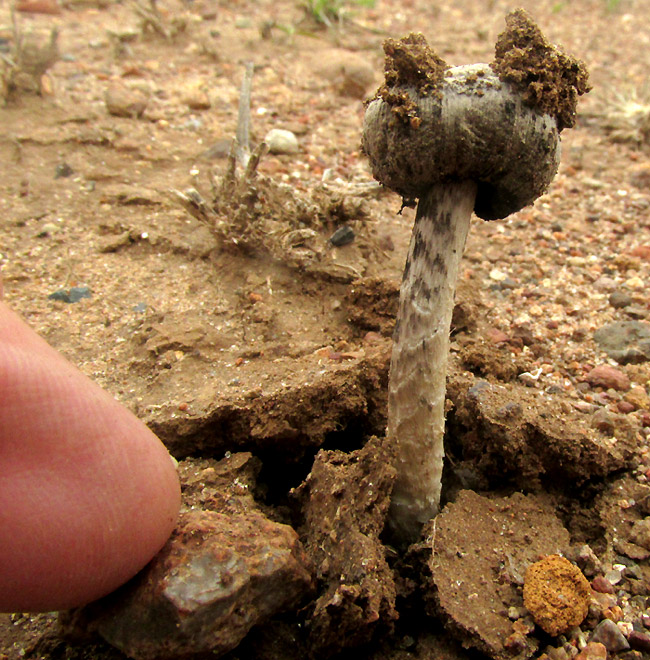
During the ongoing two-year dry period classified by the North American Drought Monitor as an extreme D3 drought, about four days after a modest rain, the above small mushroom emerged from sandy, crusty soil. Long ago the original semiarid, deciduous forest dominated by low-growing, spiny mesquite and acacias had been converted to cornfields which, once the soil was depleted, became low-grade pasture for livestock, and now is abandoned, with only wandering flocks of sheep visiting when there's something to nibble, which currently there isn't. At the picture's bottom, right, there's a bleached sheep-dung pellet.
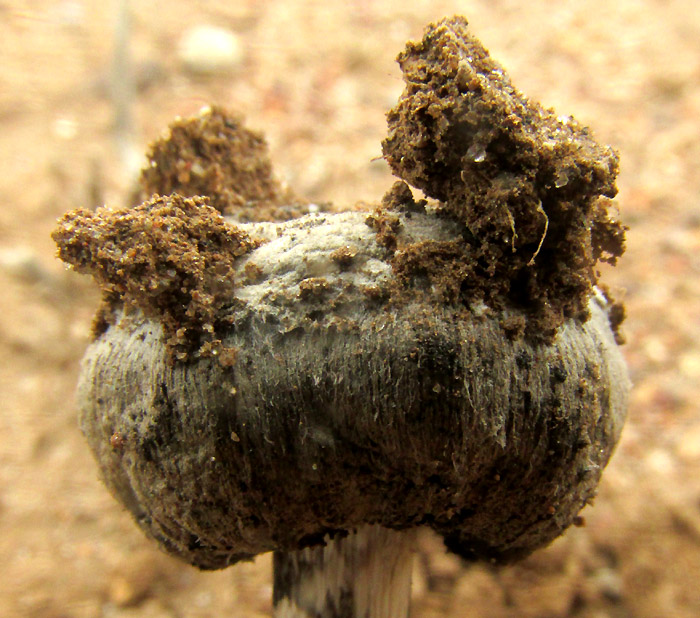
Up close, the cap is seen as somewhat scaly or shaggy, similar to what's seen on the much larger Shaggy Mane. Note that as the cap's edges curl downward, they darken, and the rim is irregular with blackish graininess. This also is similar to the Shaggy Mane, which belongs to the genus Coprinus, species of which are regarded as inkcaps because their quickly disintegrating caps melt into inky-black goo. Our mushroom's cap seemed too tough to melt, but still gives the impression of being closely related to the inkcaps.

In mushroom identification often it's helpful to know how the spore-producing gills attach to the stalk, or stipe. Above, the gilled cap gradually narrows in its center to become the stipe. In many species there's a notch between the stipe and the gills.
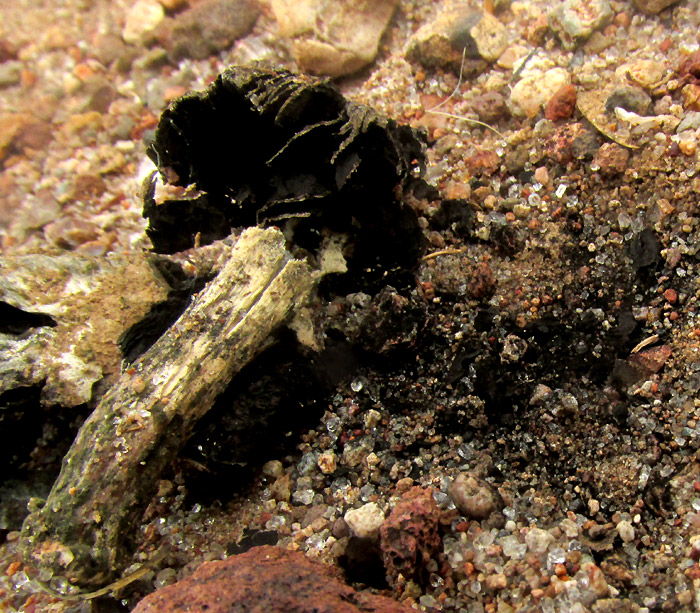
Above, a mushroom knocked down by a dog has left a spore atop the sand indicating that the spores are black, which is right for inkcaps. Also, notice how the cap's margin is raggedy-fringed, something not seen in the inkcap genera.
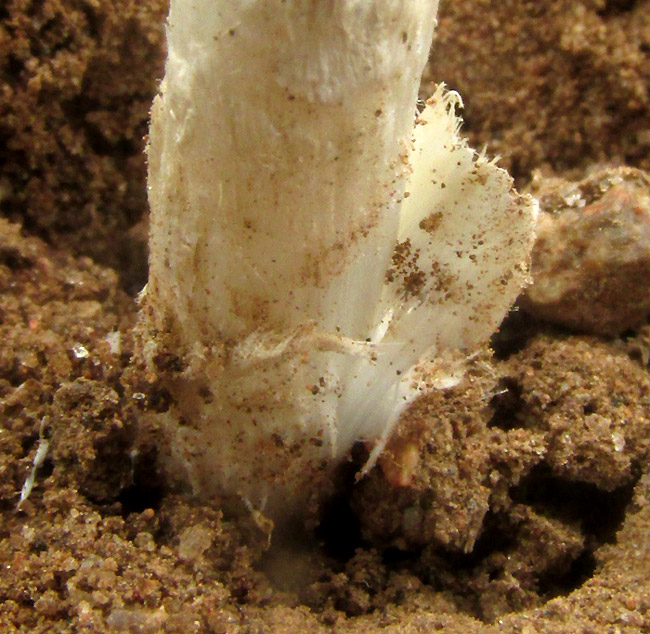
The stipe bears no ring, or annulus, but at the base arises from a cuplike volva. The volva is unusually loose and fragile. David Arora's 1986 book Mushrooms Demystified describes this species' volva as two-layered, with the outer layer white and ample, the inner layer composed of tough fibers.
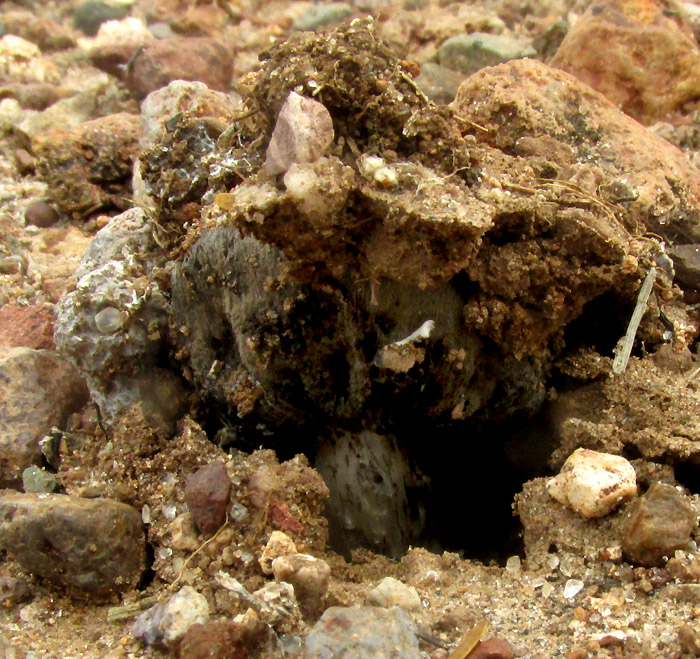
The day after finding this species I returned to see how the mushrooms had developed. I couldn't find them, but now numerous widely scattered populations of new mushrooms were just pushing through the crust, shown above. Now it's apparent that the species is common in this area, though their populations are spotty. Above, on the left of the emerging mushroom, I'm unsure what the object with hexagonal patterns is; possibly another mushroom species, or fossilized coral?
This mushroom was identified with an Internet image search using the keywords "mushroom desert." Matching pictures popped up under the name Desert Inkcap, MONTAGNEA ARENARIA.
Montagnea arenaria is indeed closely related to the inkcaps, despite Montagnea species not producing caps which melt into inky stuff. Mantagnea is a small genus of only seven currently recognized species, of which Montagnea arenaria is by far the most widely distributed and commonly encountered. It's been documented in much of the world, but mostly in southwestern North America south to central Mexico, southern Eurasia and Australia.
Kathryn Jacobson's 1996 study "Macrofungal ecology in the Namib desert: a fruitful or futile study?", found that in Namibia's Namib desert Montagnea arenaria mainly appeared around isolated acacia trees where Oryxes -- antelopes with long, straight horns -- gathered, forming "dung middens." In general desert mushrooms there emerged soon after rare rains, whatever the time of year, and where Oryxes left their dung. That fits our emergence of Montagnea arenaria soon after a rain, where sheep leave their poop.
The 2013 MS thesis by Yuliana Venegas Ramírez entitled "Etnomicología Zapoteca de San Pedro Mixtepec, Sierra Sur de Oaxaca, México," reports that Zapotec people in Oaxaca, Mexico eat Montagnea arenaria both raw and added to stews. On the other hand, the 2022 study by Joshua Anthuan Bautista-González and others entitled "Traditional knowledge of medicinal mushrooms and lichens of Yuman peoples in Northern Mexico," reports that the Yuman people consider Montagnea arenaria to be toxic.